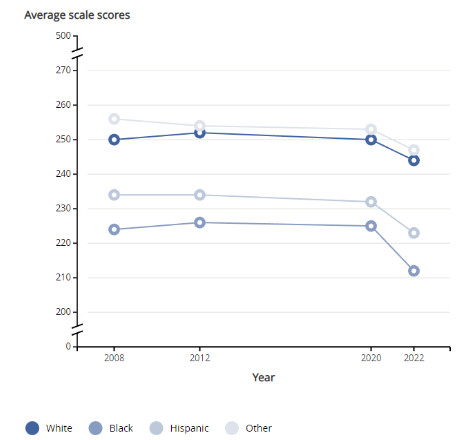Recently, results from the National Assessment for Educational Progress (NAEP) for 2022 were released. This was a special administration of the exam, focused on reading and mathematics performance among 9 year–olds. To those who have been paying attention to recent results in Wisconsin, the results were probably not all that surprising. But it does continue the narrative that the school closure policies implemented in many parts of the nation were particularly problematic for low-income and minority students.
The figure below shows NAEP performance in math broken down by racial groups. Among African American and Hispanic students, all of the gains of the two past decades appear to have been wiped out. The story for English looks very much the same. The results for low-income students are not much better. Scores in mathematics were the lowest since 2004, and scores in reading were just one point above the all-time low that occurred in 2004.
Figure. NAEP Mathematics-9 Year Olds by Race (2008-2022)

Why has this happened? One clear answer lays in the school shutdown policies that were prevalent in 2020 and 2021. In 2021, WILL conducted a study examining the factors in where proficiency drops were the largest on the Forward Exam in the aftermath of COVID. We found that drops were significantly larger in districts that remained shut down for the long term. Other research showed clearly that closure decisions were more motivated by politics than concerns about the pandemic. COVID rates in communities showed no relationship to whether a school was open or not—what mattered instead was the existence of teachers unions and the liberalness of the community. The result of this reality was that larger districts with more low-income and minority students were more likely to stay shutdown.
Wisconsin has long had some of the largest racial achievement gaps in the country. While the NAEP data available so far doesn’t allow for a specific breakdown of Wisconsin’s results, there is reason to believe that the dramatic results we see nationwide here will be even more extreme in our state. Despite recent claims that Wisconsin is among the top ten states in the nation for education, the problems resulting from school shutdowns have created massive gaps that it will be difficult for schools to overcome.
There is little reason to believe that public schools won’t return to shutdown policies in the future if COVID rates tick up. As late as the Spring of this year, some school districts in Wisconsin were still maintaining mask mandates, despite widespread availability of the vaccine for adults and almost zero chance of serious illness among children.
In light of this reality, the solution seems to lie in ensuring that no family is stuck in a school that is guided by the whims of teachers unions. According to research from the Policy Forum, private schools were less likely to go virtual during the pandemic than public schools. Currently in Wisconsin, school choice is limited to families that fall below certain poverty thresholds, leaving many families that cannot afford private education without options. In the next year, there is a great opportunity to expand eligibility so that all families can choose the schools that work best for them. By expanding school choice, and putting pressure on public schools to do their job better, we can begin to solve these daunting problems.